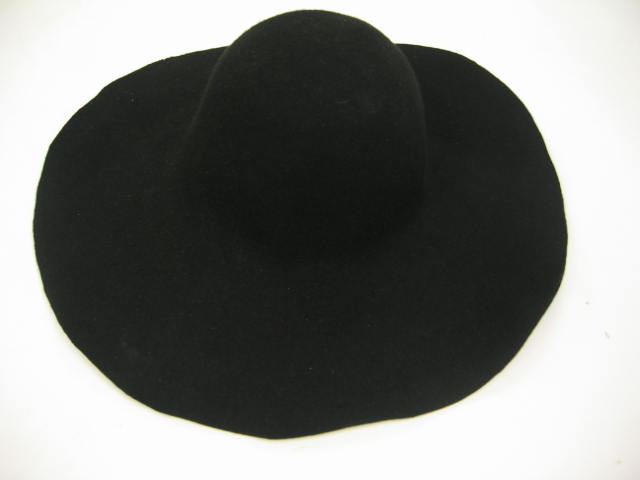Making Felt Hats - Information
History
Wool and fur felt hats are made using the felting process.
The felting process is among the earliest textile processing known to mankind. It was an integral part in the survival and spread of Asian nomadic
tribes. The felting process has been known to mankind since the Neolithic period.
Felting
The process includes dipping the animal fibers alternatively in
hot and cold water with agitation solutions to “shock” the fibers. During this agitation process, the hair’s microscopic scales lock and intertwine with each other
into an irreversible “felt.” Throughout history, the felting process included using the agitation solutions of mercury nitrate. The exposure to mercury fumes
would cause the hatters to have dementia. The effects of the mercury fumes is what lead to the famous phrases “mad as a hatter” or “mad hatter.” The phrase “The
Mad Hatter” was also popularized by Lewis Carroll’s book, Alice’s Adventure in Wonderland. In the book, The Mad Hatter is a fictional character brought out by
Carroll during the tea party scene and later, in the trial section of the book.
Making Felt Hats
 Most felt hats are either 100% wool, 100% fur or a mixture of wool and fur. Wool felt is derived from sheep
and fur felt is mainly derived from rabbit, hare, and beaver. Some companies such as Stetson have incorporated the use of chinchilla and mink fur to yield high end fur hats. Stetson also
introduced two new lines of felt hats using genuine buffalo and bison fur. A mixture of different furs sometimes yield a felt hat which is more shape retaining and longer lasting. Most felt hats are either 100% wool, 100% fur or a mixture of wool and fur. Wool felt is derived from sheep
and fur felt is mainly derived from rabbit, hare, and beaver. Some companies such as Stetson have incorporated the use of chinchilla and mink fur to yield high end fur hats. Stetson also
introduced two new lines of felt hats using genuine buffalo and bison fur. A mixture of different furs sometimes yield a felt hat which is more shape retaining and longer lasting.
After the skins are collected and shipped to the hat manufacturing company, the skins need to be prepared
before the fur can be used in production. The cured animal skins need to be split and the long, coarse and lustrous guard hair on the outer surface of the pelt needs to be removed.
It is difficult to get the coarse outer hairs to felt if not impossible. It is the soft under fur that is used to make felt that's. The under fur is the layer which actually provides
warmth and insulation.
Next, the fur is laid out and run through a shearing shed where the fur is removed and cut to even lengths.
Then it is passed through a cleaning procedure where high intense blowers force the furs to separate in air, very like that of a cyclone. This process allows the heavier impurities such
as dirt and skin to fall out and into a catcher at the bottom. The fur is passed through this process several times in order to clean the fur. There are still some hat companies which
use a washing process to clean the fur. This process may include using a specially formulated cleaning solution or sometimes with a mild acid solution. Afterwards, the fur must be
properly dried before the felting process begins.
The furs are blended accordingly to each hat manufacturing company's specification. (Note: each company's
blend may vary from another's even if the X's are the same.) The fur is weighed exactly enough for one hat and then passed through a forming machine which beings the hat body creation
process. Using hot water and pressure, the fur begins to interlock into the shape of the cone which is approximately 3 feet tall. After the fur has the shape of the cone, it is passed
through rollers which again uses hot water, cold water and pressure to further promote the felting process. This rigorous felting process will cause the felt hat body cone to shrink to
about half of its beginning height and much thicker than how it began. The felt hat body is now ready for the dyeing process. Specially formulated dyes are used to obtain the desired
colors. After the dyeing process, the felt hat body is again passed through the rollers to allow the color to set.
The felt hat body is now ready to be blocked and transformed into a hat. The amount of heat and pressure
(PSI) will vary from company to company. After the blocking process is completed, the hat's brim and crown is run through finishing machines in which the finest sandpapers are used to
sand the extra hairs off and even out and smooth the surface of the hat. The brim is then cut to the desired length and the raw edge sanded. Now the felt hat is ready for the trimming
process. This process includes adding sweat bands, linings, hatbands, feathers, etc.
The completed felt hat is now taken to the quality control center in which the felt hats are individually
inspected for errors. If it does not pass inspection, the hat is either fixed (when possible) or is separated to become second quality hats or irregular hats. When the hat passes the
inspection process, it is brushed one last time, bagged and inserted in a hat box. The felt hat is now ready to be shipped to your local hat store or to a company that wholesale hats.

Cowboy Hat Info is the leading source of historical and comtemporary hat
information. The wealth of straw hat and felt hat knowledge has been
gathered through generations of hatters. From Stetson Hats to Summit
Hats and making straw hats to making felt hats, Cowboy Hat Info covers it all.
Copyright 2006 Cowboy Hat Info
All Rights Reserved
|